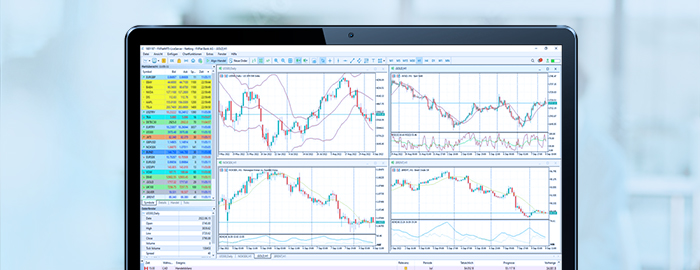Forex Trading - Everything about Foreign Exchange Trading
Forex trading is known to most investors from their holiday travels. But did you know that the foreign exchange market is many times bigger than the stock market? Up to $ 7.5 trillion change hands every day around the world.
In forex trading, investors rely on changes in exchange rates.
How Forex trading works and how to become a Forex trader at FXFlat, your CFD and Forex broker, is explained on this page.

Opportunities and Risks in Forex Trading
The foreign exchange market - also known as foreign exchange market, forex or "FX" - is a lever trade. This means that even small amounts of money can be moved. For each trade, only a security deposit, the so-called margin is deposited. If, for example, a 20: 1 lever is used, positions with a value of € 20,000 can be moved with a margin of € 1,000. Trader benefit fully from the price development, even if only a small amount is actually invested.
It should be noted, however, that the leverage can be knocked out in both directions. Thus, on the one hand disproportionately high profits and on the other very high losses possible. Therefore Forex trading is especially suitable for people who already have some trading experience. Comprehensive basic knowledge is essential for successful currency pair trading.
Suppose you think that the EUR / USD exchange rate will rise in the next few days and buy a CFD at a price of 1.0700. The CFD in this example equals 10,000 units in the base currency. Furthermore, we assume that the margin is one percent and you therefore have to deposit at the opening of the position a security deposit of 100 euros (0.01 x 10,000).
The euro is gaining against the dollar as expected and closing the position at 1.0750. There will be a difference of 0.0050 (1.0750-1.0700) between the opening price and the closing price of the position. The profit (and loss) is calculated on the basis of the exchange rate. In our case, you have made a profit of 50 dollars (0.0050 x 10.000). Once the profit has been realized, the position is converted into euros, which corresponds to an amount of approximately 46.51 euros. The value date (value date) is immediate.
What Currency Pairs Are Available?
The majority of foreign exchange trading takes place in the major currencies: the US dollar, the euro, the yen, the pound, the Swiss franc, the Australian dollar and the Canadian dollar.
Majors:
Currency pairs of the key currencies that contain the USD are referred to as "majors". Depending on convention, the New Zealand dollar is also counted among these.
Minors:
Other currency pairs are referred to as "minors" or "crossing". A minor currency pair is composed of key currencies that are not the USD. So they are combination of the above mentioned key currencies.
Exotics:
"Exotic" is the term used for currency pairs that include a currency of a developing economy.
What Forex Pairs Are Tradeable at FXFlat?
Spot trading is about a trade that is settled immediately. Payment is on delivery. This is where the term spot trade comes in (Forex spot, Spot market or Forex spot market are other terms that describe the same currency spot trading). Trading takes place within the deadline at the spot rate. Most of the forex spot trading is conducted between large banks (interbank trading). It is generally traded on margin. FXFlat collects this security amounting to 0.5% of the commercial value.
Differences Between Trading Forex CFDs and Spot Forex
At FXFlat you are in the comfortable situation to trade currencies either with classic Forex CFDs or as spot foreign exchange transactions (Forex Spot) in direct Forex Kassa. In the following we would like to present you the most important differences and features.
Differences at a Glance
| Forex Spot | Forex CFD | |
|---|---|---|
| Leverage | 1:200 | up to 1:33 |
| Spread | from 1.0 | from 0.6 |
| Trading times | 00:00 a.m. - 10:00 p.m. CET | 24h |
| With rollover | No. Only tradeable intraday. | Yes |
| Pricing | Multilateral | Bilateral |
Forex CFDs are derivatives issued by an issuer with a fixed reference to a specific reference market.
Spot foreign exchange transactions (forex spot), on the other hand, are the reference market itself and a spot transaction, i.e. the cash. The forex spot price of a currency pair, is determined by all market participants and not just by a single market maker or issuer as is the case with CFDs.
Digression: The price of a CFD from provider A is also determined only by him and may differ from provider B or even the reference market. In Forex Spot, bid and ask prices are set by different market participants and are completely independent of each other. There is no fixed spread between bid and ask prices. The price can even be inverse, so the spread is quoted in favor of the client.
Forex CFD trading is a bilateral OTC trade while spot forex trading is a multilateral OTC trade. This means that you have to buy a CFD only from the respective issuer, and it is also mandatory to sell it. In spot FX trading, for example, a currency can be bought at bank A and sold at bank B.
For the respective market participants (bank, market maker, etc.) it is not apparent whether a position is opened or closed in the securities account with a purchase or sale and there is also no participation in the profit or loss of the customer or investor. At FXFlat you can ask for each individual trade to be disclosed at which executing agency was bought or sold for you.
In Forex spot trading, a delivery of the traded currency with value date after 2 business days is provided - equivalent to the purchase of a share. However, FXFlat excludes a physical delivery. Background is that customers of FXFlat do not want a delivery of the currency. FXFlat also does not guarantee delivery as no overnight trading is offered and clients must close all positions intraday. Any open Forex spot positions are forcibly liquidated from 22h. Forex CFDs, on the other hand, are tradable 24 hours continuously and are charged with financing costs, which do not exist in Forex Spot trading at FXFlat. The value date in FX trading is 2 business days.
Forex Trading Hours
Forex CFDs can be traded at FXFlat in the period from Sunday to Friday continuously from 23:00 CET - 23:00 CET.
Forex Spot trading, on the other hand, is exclusively tradable intraday in the period from Monday to Friday 00:00 CET - 22:00 CET.
Important Terms in Forex Trading
The spread is calculated as the difference between the buying and selling value of a currency. This is a type of fee that FXFlat charges for each trade.
An overview of FXFlat spreads can be found on the following page: Contract Specification
Margin is a type of collateral that a trader deposits with a broker for a trade. The margin defines how high the maximum lever can be. If the margin for a bet of 10,000 euros at one percent, the trader must deposit 100 euros with his broker.
The margins at FXFlat can be found on the page: Conditions
The price interest point is a unit used for FX trading. With it, the price change of a currency pair can be specified.
Example: In the case of the euro-dollar exchange rate, a move from 1.2034 to 1.2035 dollars represents a pip. In dollar yen, a move from 105.43 to 105.44 yen is a pip.
The full lot (1.00) is a trading unit in currency trading. A lot usually stands for 100,000 units (in the respective base currency). If two lots are traded on the EUR / USD currency pair, it is about 200,000 euros.
FXFlat also offers mini lots with 10,000 (0.10) and micro lots (0.01) with 1,000 units. If a currency pair is quoted in the form of EUR / USD, the EUR is the base currency and the USD is the trading currency.
This makes it possible to achieve very high returns in FX trading. The lever multiplies the gain or loss on rising or falling prices after the purchase. FXFlat offers its customers different levers for different products. Depending on the size of the lever, appropriate collateral (margins) must be deposited. The lever indicates which capital investment is deposited as collateral for a specific position. The lower the safety performance, the higher the lever. The higher the lever, the higher the risk, since the security is used up proportionately faster.
A margin call is called a margin request. Only CFD Trading with the Account Type Professional Classic could cause additional interest - Standard- and Professional Plus clients are excepted (Account packages with FXFlat). This means that the customer must clear his account again, as long as there was an overdraft of the margin account during the exchange rate fluctuations.
In currency trading, different currency pairs have a wide variety of liquidity. This is significantly dependent on the demand of different currencies. If the demand is high (such as the EUR / USD) is usually offered a high liquidity. If the demand is rather low (such as the MXN / CZK) so liquidity is rather low. Price fluctuations are therefore enormous, so that Gaps could be possible.
A gap is between two quoted prices.
In highly liquid markets, the price is usually continuous (e.g. 1,13 – 1,14 – 1,15 - …).
In illiquid markets the price can jump too (e.g. 1,15 – 1,16 – 1,21 – 1,22 – 1,38 - …)
This may be at the expense of a stop order, e.g. then no longer exactly. One then speaks of slippage. Gaps can also occur between the close of trading (Friday evening) and the start of trading (Sunday evening).
Slippage is the difference between a desired course and the course to which it was actually run. If you have clicked on the price of 105 in a market order, you have the order to buy / sell at the next tradable price. However, if it is done at 106, the slippage is 1 point (difference between 105 and 106). Depending on the time of trading, this may be more pronounced (for example European night times - thin liquidity) or rather less at European lunchtime.
Depending on market conditions, FXFlat can lead to a positive or negative slippage.
The foreign exchange swap rate is defined as an overnight or rollover interest (credit or debit) for holding positions overnight in a forex trading or CFD deal.
A charge / reward on a swap depends on the interest rate differentials of the countries whose currencies are involved in the currency pair and whether it is a long or a short position. Each currency pair has its own swap rate. This is indicated in points. The amount of the debit / credit in the swap transaction depends on the respective position size.
Swap rates are dependent and therefore directly linked to the interest rate policy of the central banks and the liquidity of the markets for interbank loans.
This Might Also Interest You





